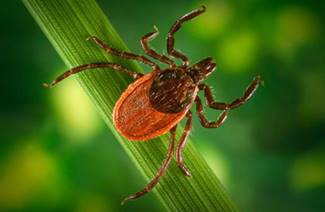| Lyme
Disease |
 |
|
| |
| General Information |
-
Lyme
Disease is classified as a
vector-borne,
zoonotic illness – it is spread by
ticks
(the
vector,
or agent of transmission). The organism which causes Lyme disease is
a spiral-shaped
bacterium
called
Borrelia burgdorfei and it has been found in two species of ticks
collected from many areas of BC including Vancouver Island, the
Lower Mainland, the Sunshine Coast, the Fraser Valley and the
Kootenays.
-
The
tick
that spreads Lyme Disease in BC is the
blood-feeding western black-legged
tick
(Ixodes
pacificus), which
are about the size of a sesame seed.
-
While most
tick
bites do not result in disease, some do.
-
In BC, less than 1 percent of
ticks
tested carry the bacteria
that causes Lyme Disease, and there is only a very small chance of
the bacteria being transmitted to a human that has been bitten.
However, the disease can be
serious, so it is worth taking steps to avoid being bitten.
-
Ticks
prefer habitat that includes wooded regions and areas
with tall grass; this habitat preference also coincides with the
preferred habitat of their primary host, black-tailed deer (Odocoileus hemionus).
-
Ticks
attach to people or animals as they pass by,
burrow part way into the skin, bite, draw blood, then drop off.
-
Ticks
are easiest to spot when they are feeding on a host.
During the blood meal, only the mouth parts of
ticks are inserted beneath the skin of the host, while the
posterior body remains exterior to the host’s body. Once fully
engorged with blood,
ticks
detach and move onto vegetation.
-
As of 2013, there have been
over 60 confirmed cases of Lyme Disease in British Columbia.
|
| Images |
|
Click on
image to enlarge. |
 |
|
Western black-legged ticks (Ixodes pacificus) is responsible for the
spread of Lyme Disease along the Pacific coast, mostly in southern
British Columbia. (Source: Public Health Image Library (PHIL). James
Gathany; William Nicholshon. Available online:
http://phil.cdc.gov.) |
|
| Symptoms and
Treatment |
|
Symptoms: |
-
If you have the following symptoms within days or weeks
after being bitten by a tick, consult your family physician
or other healthcare professional. Tell your doctor when and
where you were bitten by a tick.
-
Symptoms include a skin rash that looks like a "bull's eye"
and may be quite large
(5
cm or 2 inches) in diameter may develop.
It
often spreads out from where the
tick
bite was.
-
Also, general symptoms of:
-
fever;
-
headache;
-
muscle and joint pains;
-
fatigue or weakness of the muscles of the face;
-
In some cases paralysis may occur. The paralysis usually
starts in the feet and legs and gradually works its way up
to the upper body, arms and head. This paralysis can develop
from within a few hours to several days.
|
|
Treatment: |
-
Most cases of Lyme Disease can be treated successfully with
a course of antibiotics, especially if caught early.
Untreated, Lyme Disease can affect the joints, the heart and
the nervous system and is much more difficult to treat.
|
|
| Avoiding Ticks |
-
To protect yourself against tick
and insect bites:
-
walk
on cleared trails wherever possible in areas of tall
grass or woods;
-
wear
light-colored clothing, tuck your top into your pants
and tuck your pant legs into your boots or socks;
-
put
insect repellent containing DEET on all exposed skin.
Reapply as frequently as directed on the container;
-
check clothing and scalp (covered or not) when leaving
an area where
ticks
may live;
-
check in folds of skin. Use good lighting and have
someone help you check hard-to-see areas. When a
tick
is located, remove it immediately. Check the whole
body! Don't stop when you find one
tick, as there may be
more;
-
regularly check household pets for
ticks.
|
|
| What To Do If You Find a Tick on Your
Skin or Scalp |
-
Use tweezers or
forceps to gently get a hold of the
tick
as close to the skin as possible. Don't touch the
tick
with your hands.
-
Without squeezing the
tick, steadily lift it straight off the skin. Avoid jerking
it out. Try to make sure that all of the
tick
is removed.
-
Once the
tick
has been removed, clean the bite area with soap and
water then disinfect the wound with antiseptic cream. Wash hands
with soap and water.
-
If possible, save the
tick
in a container with a tight fitting top. If the
tick
is alive, dampen a small cotton ball with water and put
it into the container to keep the
tick
alive. (A live
tick
is necessary for culturing the
bacteria
that causes Lyme Disease.) Label the container with the date, name
and address of person bitten or what type of animal the
tick
was from, what part of the body was bitten, and what
part of the province the
tick
probably came from. Also include the name and address
of your family physician.
-
Ask your doctor for further advice.
|
|
For laboratory testing, this container should be mailed as soon as
possible to: BCCDC Laboratory Services,
Parasitology Section,
655 West 12th Ave.,
Vancouver V5Z 4R4 BC Canada
|
|
| Further Reading |
|
|
|
|

